2008 NISSAN ALTIMA HYBRID wheel
[x] Cancel search: wheelPage 26 of 54
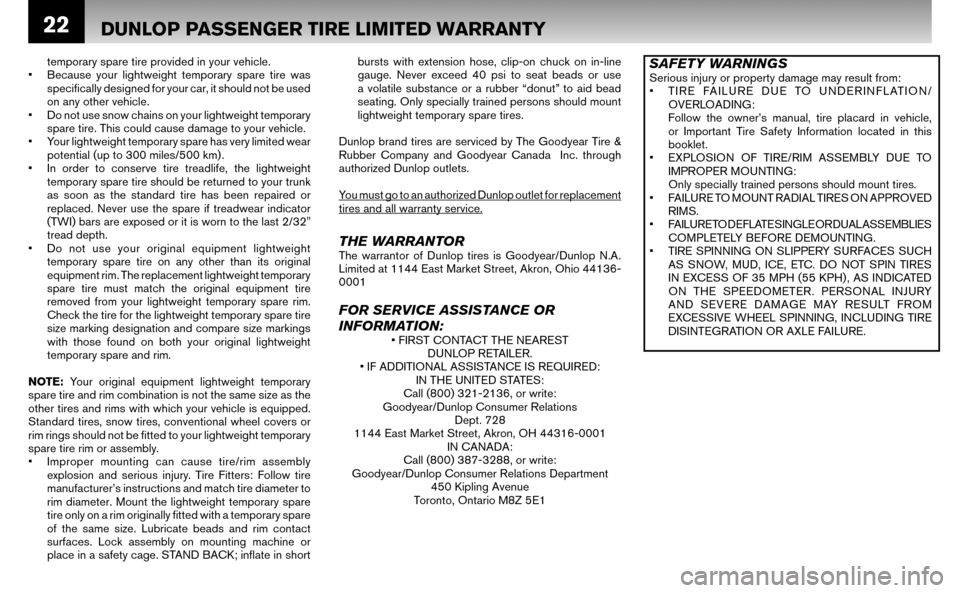
22
temporary spare tire provided in your vehicle.
• Because your lightweight temporary spare tire was specifi cally designed for your car, it should not be used
on any other vehicle.
• Do not use snow chains on your lightweight temporary spare tire. This could cause damage to your vehicle.
• Your lightweight temporary spare has very limited wear potential (up to 300 miles/500 km) .
• In order to conserve tire treadlife, the lightweight temporary spare tire should be returned to your trunk
as soon as the standard tire has been repaired or
replaced. Never use the spare if treadwear indicator
(TWI) bars are exposed or it is worn to the last 2/32"
tread depth.
• Do not use your original equipment lightweight temporary spare tire on any other than its original
equipment rim. The replacement lightweight temporary
spare tire must match the original equipment tire
removed from your lightweight temporary spare rim.
Check the tire for the lightweight temporary spare tire
size marking designation and compare size markings
with those found on both your original lightweight
temporary spare and rim.
NOTE: Your original equipment lightweight temporary
spare tire and rim combination is not the same size as the
other tires and rims with which your vehicle is equipped.
Standard tires, snow tires, conventional wheel covers or
rim rings should not be fi tted to your lightweight temporary
spare tire rim or assembly.
• Improper mounting can cause tire/rim assembly explosion and serious injury. Tire Fitters: Follow tire
manufacturer’s instructions and match tire diameter to
rim diameter. Mount the lightweight temporary spare
tire only on a rim originally fi tted with a temporary spare
of the same size. Lubricate beads and rim contact
surfaces. Lock assembly on mounting machine or
place in a safety cage. STAND BACK; infl ate in short
DUNLOP PASSENGER TIRE LIMITED WARRANTY
bursts with extension hose, clip-on chuck on in-line
gauge. Never exceed 40 psi to seat beads or use
a volatile substance or a rubber “donut” to aid bead
seating. Only specially trained persons should mount
lightweight temporary spare tires.
Dunlop brand tires are serviced by The Goodyear Tire &
Rubber Company and Goodyear Canada Inc. through
authorized Dunlop outlets.
You must go to an authorized Dunlop outlet for replacement
tires and all warranty service.
THE WARRANTOR The warrantor of Dunlop tires is Goodyear/Dunlop N.A.
Limited at 1144 East Market Street, Akron, Ohio 44136-
0001
FOR SERVICE ASSISTANCE OR
INFORMATION:
• FIRST CONTACT THE NEAREST DUNLOP RETAILER.
• IF ADDITIONAL ASSISTANCE IS REQUIRED: IN THE UNITED STATES:
Call (800) 321-2136, or write:
Goodyear/Dunlop Consumer Relations Dept. 728
1144 East Market Street, Akron, OH 44316-0001 IN CANADA:
Call (800) 387-3288, or write:
Goodyear/Dunlop Consumer Relations Department 450 Kipling Avenue
Toronto, Ontario M8Z 5E1
SAFETY WARNINGSSerious injury or property damage may result from:
• TIRE FAILURE DUE TO UNDERINFLATION/ OVERLOADING:
Follow the owner’s manual, tire placard in vehicle, or Important Tire Safety Information located in this
booklet.
• EXPLOSION OF TIRE/RIM ASSEMBLY DUE TO IMPROPER MOUNTING:
Only specially trained persons should mount tires.
• FAILURE TO MOUNT RADIAL TIRES ON APPROVED RIMS.
• FAILURE TO DEFLATE SINGLE OR DUAL ASSEMBLIES COMPLETELY BEFORE DEMOUNTING.
• TIRE SPINNING ON SLIPPERY SURFACES SUCH AS SNOW, MUD, ICE, ETC. DO NOT SPIN TIRES
IN EXCESS OF 35 MPH (55 KPH) , AS INDICATED
ON THE SPEEDOMETER. PERSONAL INJURY
AND SEVERE DAMAGE MAY RESULT FROM
EXCESSIVE WHEEL SPINNING, INCLUDING TIRE
DISINTEGRATION OR AXLE FAILURE.
Page 28 of 54
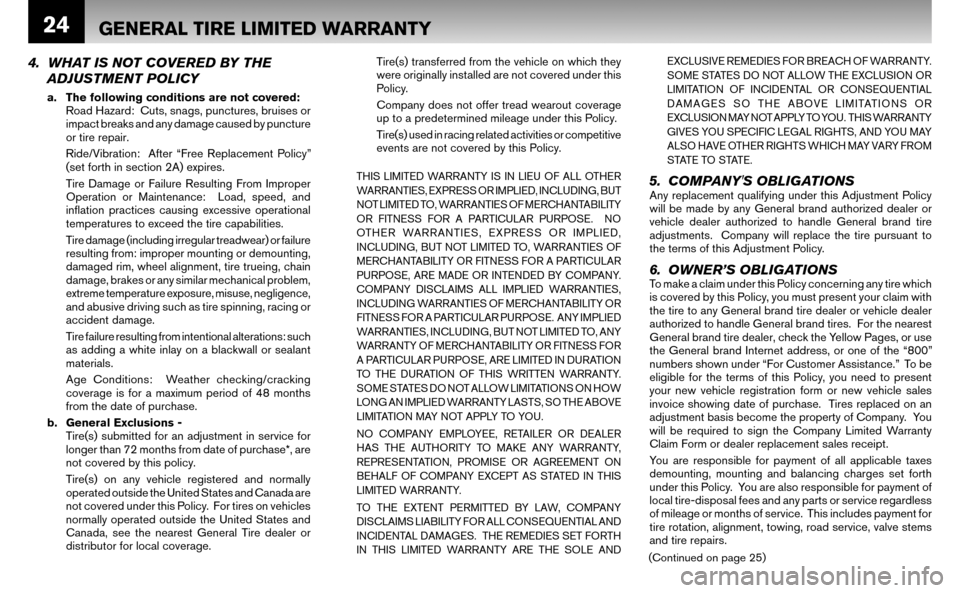
24
4. WHAT IS NOT COVERED BY THE ADJUSTMENT POLICY
a. The following conditions are not covered:
Road Hazard: Cuts, snags, punctures, bruises or
impact breaks and any damage caused by puncture
or tire repair.
Ride/Vibration: After “Free Replacement Policy” (set forth in section 2A) expires.
Tire Damage or Failure Resulting From Improper Operation or Maintenance: Load, speed, and
infl ation practices causing excessive operational
temperatures to exceed the tire capabilities.
Tire damage (including irregular treadwear) or failure resulting from: improper mounting or demounting,
damaged rim, wheel alignment, tire trueing, chain
damage, brakes or any similar mechanical problem,
extreme temperature exposure, misuse, negligence,
and abusive driving such as tire spinning, racing or
accident damage.
Tire failure resulting from intentional alterations: such as adding a white inlay on a blackwall or sealant
materials.
Age Conditions: Weather checking/cracking coverage is for a maximum period of 48 months
from the date of purchase.
b. General Exclusions -
Tire(s) submitted for an adjustment in service for
longer than 72 months from date of purchase*, are
not covered by this policy.
Tire(s) on any vehicle registered and normally operated outside the United States and Canada are
not covered under this Policy. For tires on vehicles
normally operated outside the United States and
Canada, see the nearest General Tire dealer or
distributor for local coverage. Tire(s) transferred from the vehicle on which they
were originally installed are not covered under this
Policy.
Company does not offer tread wearout coverage up to a predetermined mileage under this Policy.
Tire(s) used in racing related activities or competitive events are not covered by this Policy.
THIS LIMITED WARRANTY IS IN LIEU OF ALL OTHER
WARRANTIES, EXPRESS OR IMPLIED, INCLUDING, BUT
NOT LIMITED TO, WARRANTIES OF MERCHANTABILITY
OR FITNESS FOR A PARTICULAR PURPOSE. NO
OTHER WARRANTIES, EXPRESS OR IMPLIED,
INCLUDING, BUT NOT LIMITED TO, WARRANTIES OF
MERCHANTABILITY OR FITNESS FOR A PARTICULAR
PURPOSE, ARE MADE OR INTENDED BY COMPANY.
COMPANY DISCLAIMS ALL IMPLIED WARRANTIES,
INCLUDING WARRANTIES OF MERCHANTABILITY OR
FITNESS FOR A PARTICULAR PURPOSE. ANY IMPLIED
WARRANTIES, INCLUDING, BUT NOT LIMITED TO, ANY
WARRANTY OF MERCHANTABILITY OR FITNESS FOR
A PARTICULAR PURPOSE, ARE LIMITED IN DURATION
TO THE DURATION OF THIS WRITTEN WARRANTY.
SOME STATES DO NOT ALLOW LIMITATIONS ON HOW
LONG AN IMPLIED WARRANTY LASTS, SO THE ABOVE
LIMITATION MAY NOT APPLY TO YOU.
NO COMPANY EMPLOYEE, RETAILER OR DEALER
HAS THE AUTHORITY TO MAKE ANY WARRANTY,
REPRESENTATION, PROMISE OR AGREEMENT ON
BEHALF OF COMPANY EXCEPT AS STATED IN THIS
LIMITED WARRANTY.
TO THE EXTENT PERMITTED BY LAW, COMPANY
DISCLAIMS LIABILITY FOR ALL CONSEQUENTIAL AND
INCIDENTAL DAMAGES. THE REMEDIES SET FORTH
IN THIS LIMITED WARRANTY ARE THE SOLE AND EXCLUSIVE REMEDIES FOR BREACH OF WARRANTY.
SOME STATES DO NOT ALLOW THE EXCLUSION OR
LIMITATION OF INCIDENTAL OR CONSEQUENTIAL
DAMAGES SO THE ABOVE LIMITATIONS OR
EXCLUSION MAY NOT APPLY TO YOU. THIS WARRANTY
GIVES YOU SPECIFIC LEGAL RIGHTS, AND YOU MAY
ALSO HAVE OTHER RIGHTS WHICH MAY VARY FROM
STATE TO STATE.5. COMPANY'S OBLIGATIONSAny replacement qualifying under this Adjustment Policy
will be made by any General brand authorized dealer or
vehicle dealer authorized to handle General brand tire
adjustments. Company will replace the tire pursuant to
the terms of this Adjustment Policy.
6. OWNER’S OBLIGATIONSTo make a claim under this Policy concerning any tire which
is covered by this Policy, you must present your claim with
the tire to any General brand tire dealer or vehicle dealer
authorized to handle General brand tires. For the nearest
General brand tire dealer, check the Yellow Pages, or use
the General brand Internet address, or one of the “800”
numbers shown under “For Customer Assistance.” To be
eligible for the terms of this Policy, you need to present
your new vehicle registration form or new vehicle sales
invoice showing date of purchase. Tires replaced on an
adjustment basis become the property of Company. You
will be required to sign the Company Limited Warranty
Claim Form or dealer replacement sales receipt.
You are responsible for payment of all applicable taxes
demounting, mounting and balancing charges set forth
under this Policy. You are also responsible for payment of
local tire-disposal fees and any parts or service regardless
of mileage or months of service. This includes payment for
tire rotation, alignment, towing, road service, valve stems
and tire repairs.
GENERAL TIRE LIMITED WARRANTY
(Continued on page 25)
Page 31 of 54
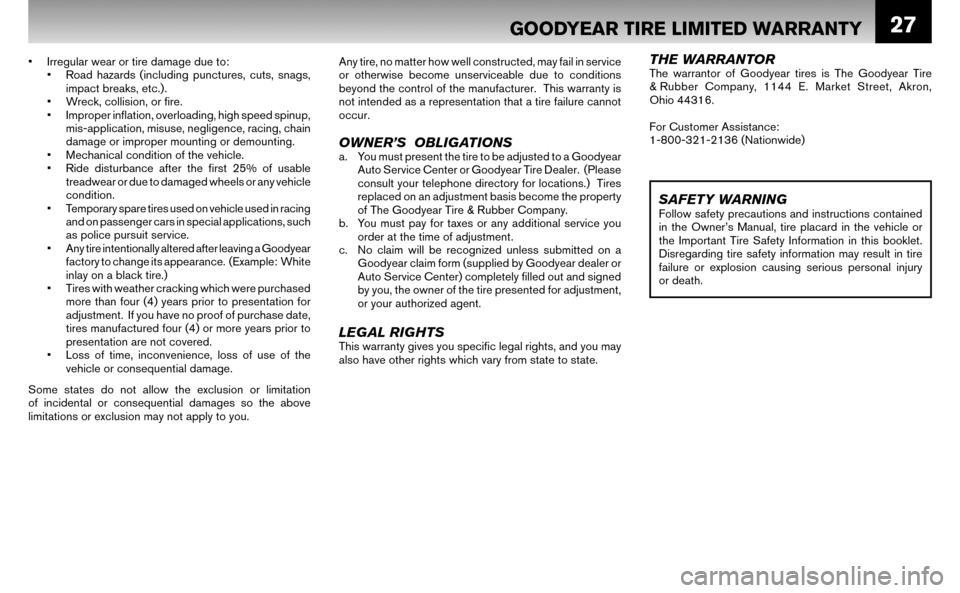
27
• Irregular wear or tire damage due to:
• Road hazards (including punctures, cuts, snags, impact breaks, etc.) .
• Wreck, collision, or fi re.
• Improper infl ation, overloading, high speed spinup, mis-application, misuse, negligence, racing, chain
damage or improper mounting or demounting.
• Mechanical condition of the vehicle.
• Ride disturbance after the fi rst 25% of usable treadwear or due to damaged wheels or any vehicle
condition.
• Temporary spare tires used on vehicle used in racing and on passenger cars in special applications, such
as police pursuit service.
• Any tire intentionally altered after leaving a Goodyear factory to change its appearance. (Example: White
inlay on a black tire.)
• Tires with weather cracking which were purchased more than four (4) years prior to presentation for
adjustment. If you have no proof of purchase date,
tires manufactured four (4) or more years prior to
presentation are not covered.
• Loss of time, inconvenience, loss of use of the vehicle or consequential damage.
Some states do not allow the exclusion or limitation
of incidental or consequential damages so the above
limitations or exclusion may not apply to you.THE WARRANTORThe warrantor of Goodyear tires is The Goodyear Tire
& Rubber Company, 1144 E. Market Street, Akron,
Ohio 44316.
For Customer Assistance:
1-800-321-2136 (Nationwide)
SAFETY WARNINGFollow safety precautions and instructions contained
in the Owner’s Manual, tire placard in the vehicle or
the Important Tire Safety Information in this booklet.
Disregarding tire safety information may result in tire
failure or explosion causing serious personal injury
or death.
Any tire, no matter how well constructed, may fail in service
or otherwise become unserviceable due to conditions
beyond the control of the manufacturer. This warranty is
not intended as a representation that a tire failure cannot
occur.
OWNER’S OBLIGATIONSa. You must present the tire to be adjusted to a Goodyear
Auto Service Center or Goodyear Tire Dealer. (Please
consult your telephone directory for locations.) Tires
replaced on an adjustment basis become the property
of The Goodyear Tire & Rubber Company.
b. You must pay for taxes or any additional service you order at the time of adjustment.
c. No claim will be recognized unless submitted on a Goodyear claim form (supplied by Goodyear dealer or
Auto Service Center) completely fi lled out and signed
by you, the owner of the tire presented for adjustment,
or your authorized agent.
LEGAL RIGHTSThis warranty gives you specifi c legal rights, and you may
also have other rights which vary from state to state.
GOODYEAR TIRE LIMITED WARRANTY
Page 32 of 54
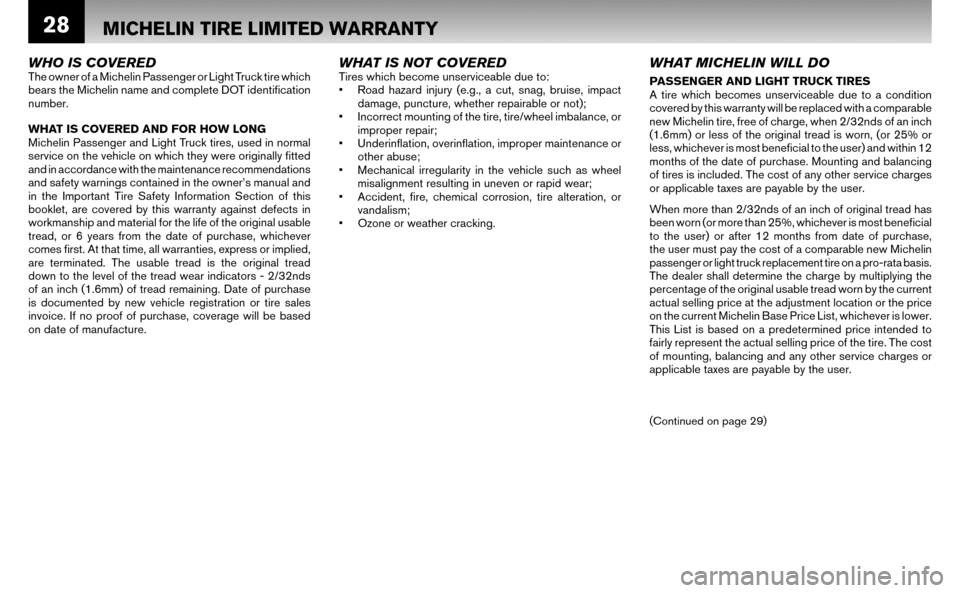
28
WHO IS COVEREDThe owner of a Michelin Passenger or Light Truck tire which
bears the Michelin name and complete DOT identifi cation
number.
WHAT IS COVERED AND FOR HOW LONG
Michelin Passenger and Light Truck tires, used in normal
service on the vehicle on which they were originally fi tted
and in accordance with the maintenance recommendations
and safety warnings contained in the owner’s manual and
in the Important Tire Safety Information Section of this
booklet, are covered by this warranty against defects in
workmanship and material for the life of the original usable
tread, or 6 years from the date of purchase, whichever
comes fi rst. At that time, all warranties, express or implied,
are terminated. The usable tread is the original tread
down to the level of the tread wear indicators - 2/32nds
of an inch (1.6mm) of tread remaining. Date of purchase
is documented by new vehicle registration or tire sales
invoice. If no proof of purchase, coverage will be based
on date of manufacture.WHAT IS NOT COVEREDTires which become unserviceable due to:
• Road hazard injury (e.g., a cut, snag, bruise, impact damage, puncture, whether repairable or not);
• Incorrect mounting of the tire, tire/wheel imbalance, or improper repair;
• Underinfl ation, overinfl ation, improper maintenance or other abuse;
• Mechanical irregularity in the vehicle such as wheel misalignment resulting in uneven or rapid wear;
• Accident, fi re, chemical corrosion, tire alteration, or vandalism;
• Ozone or weather cracking.WHAT MICHELIN WILL DO
PASSENGER AND LIGHT TRUCK TIRES
A tire which becomes unserviceable due to a condition
covered by this warranty will be replaced with a comparable
new Michelin tire, free of charge, when 2/32nds of an inch
(1.6mm) or less of the original tread is worn, (or 25% or
less, whichever is most benefi cial to the user) and within 12
months of the date of purchase. Mounting and balancing
of tires is included. The cost of any other service charges
or applicable taxes are payable by the user.
When more than 2/32nds of an inch of original tread has
been worn (or more than 25%, whichever is most benefi cial
to the user) or after 12 months from date of purchase,
the user must pay the cost of a comparable new Michelin
passenger or light truck replacement tire on a pro-rata basis.
The dealer shall determine the charge by multiplying the
percentage of the original usable tread worn by the current
actual selling price at the adjustment location or the price
on the current Michelin Base Price List, whichever is lower.
This List is based on a predetermined price intended to
fairly represent the actual selling price of the tire. The cost
of mounting, balancing and any other service charges or
applicable taxes are payable by the user.
MICHELIN TIRE LIMITED WARRANTY
(Continued on page 29)
Page 34 of 54
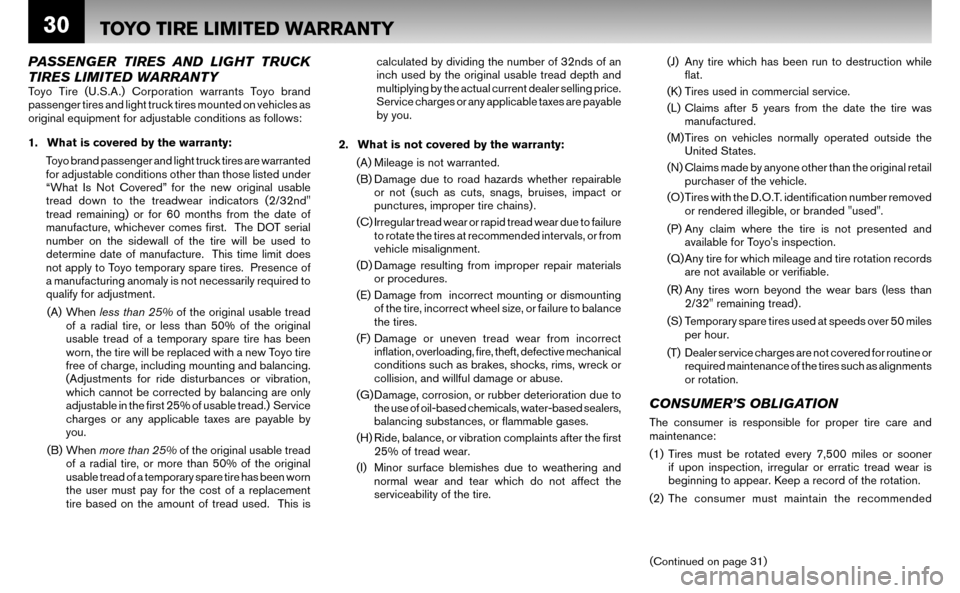
30
PASSENGER TIRES AND LIGHT TRUCK
TIRES LIMITED WARRANTY
Toyo Tire (U.S.A.) Corporation warrants Toyo brand
passenger tires and light truck tires mounted on vehicles as
original equipment for adjustable conditions as follows:
1. What is covered by the warranty:
Toyo brand passenger and light truck tires are warranted for adjustable conditions other than those listed under
“What Is Not Covered” for the new original usable
tread down to the treadwear indicators (2/32nd"
tread remaining) or for 60 months from the date of
manufacture, whichever comes fi rst. The DOT serial
number on the sidewall of the tire will be used to
determine date of manufacture. This time limit does
not apply to Toyo temporary spare tires. Presence of
a manufacturing anomaly is not necessarily required to
qualify for adjustment.
(A) When less than 25% of the original usable tread
of a radial tire, or less than 50% of the original
usable tread of a temporary spare tire has been
worn, the tire will be replaced with a new Toyo tire
free of charge, including mounting and balancing.
(Adjustments for ride disturbances or vibration,
which cannot be corrected by balancing are only
adjustable in the fi rst 25% of usable tread.) Service
charges or any applicable taxes are payable by
you.
(B) When more than 25% of the original usable tread
of a radial tire, or more than 50% of the original
usable tread of a temporary spare tire has been worn
the user must pay for the cost of a replacement
tire based on the amount of tread used. This is calculated by dividing the number of 32nds of an
inch used by the original usable tread depth and
multiplying by the actual current dealer selling price.
Service charges or any applicable taxes are payable
by you.
2. What is not covered by the warranty: (A) Mileage is not warranted.
(B) Damage due to road hazards whether repairable or not (such as cuts, snags, bruises, impact or
punctures, improper tire chains) .
(C) Irregular tread wear or rapid tread wear due to failure to rotate the tires at recommended intervals, or from
vehicle misalignment.
(D) Damage resulting from improper repair materials or procedures.
(E) Damage from incorrect mounting or dismounting of the tire, incorrect wheel size, or failure to balance
the tires.
(F) D amage or uneven tread wear from incorrect
infl ation, overloading, fi re, theft, defective mechanical
conditions such as brakes, shocks, rims, wreck or
collision, and willful damage or abuse.
(G) Damage, corrosion, or rubber deterioration due to the use of oil-based chemicals, water-based sealers,
balancing substances, or fl ammable gases.
(H) Ride, balance, or vibration complaints after the fi rst 25% of tread wear.
(I) Minor surface blemishes due to weathering and normal wear and tear which do not affect the
serviceability of the tire. (J) Any tire which has been run to destruction while
fl a t .
(K) Tires used in commercial service.
(L) Claims after 5 years from the date the tire was manufactured.
(M) Tires on vehicles normally operated outside the United States.
(N) Claims made by anyone other than the original retail purchaser of the vehicle.
(O) Tires with the D.O.T. identifi cation number removed or rendered illegible, or branded "used".
(P) Any claim where the tire is not presented and available for Toyo's inspection.
(Q) Any tire for which mileage and tire rotation records are not available or verifi able.
(R) Any tires worn beyond the wear bars (less than 2/32" remaining tread) .
(S) Temporary spare tires used at speeds over 50 miles per hour.
(T) Dealer service charges are not covered for routine or required maintenance of the tires such as alignments
or rotation.
CONSUMER’S OBLIGATION
The consumer is responsible for proper tire care and
maintenance:
(1) Tires must be rotated every 7,500 miles or sooner if upon inspection, irregular or erratic tread wear is
beginning to appear. Keep a record of the rotation.
(2) The consumer must maintain the recommended
TOYO TIRE LIMITED WARRANTY
(Continued on page 31)
Page 37 of 54
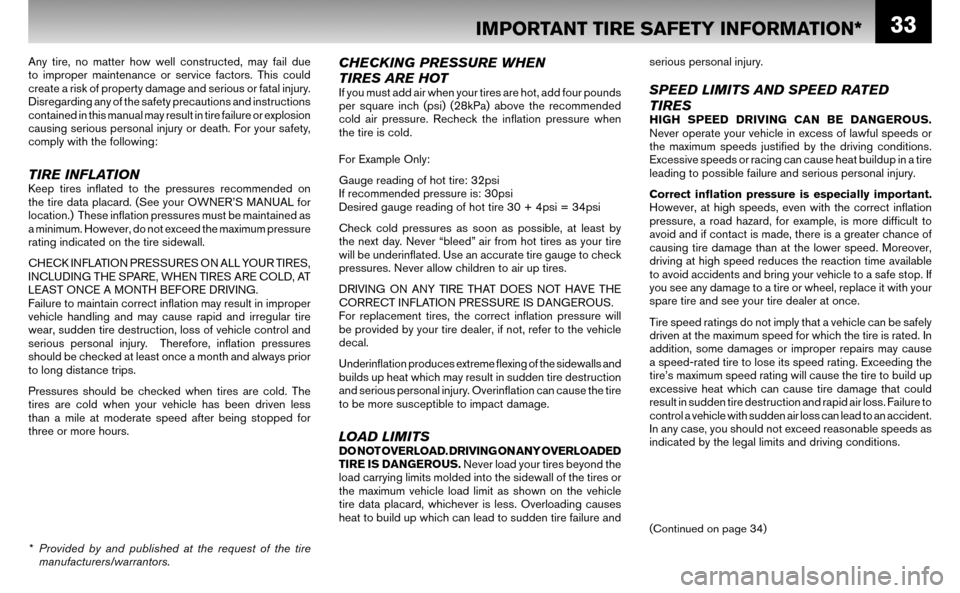
33
Any tire, no matter how well constructed, may fail due
to improper maintenance or service factors. This could
create a risk of property damage and serious or fatal injury.
Disregarding any of the safety precautions and instructions
contained in this manual may result in tire failure or explosion
causing serious personal injury or death. For your safety,
comply with the following:
TIRE INFLATIONKeep tires infl ated to the pressures recommended on
the tire data placard. (See your OWNER’S MANUAL for
location.) These infl ation pressures must be maintained as
a minimum. However, do not exceed the maximum pressure
rating indicated on the tire sidewall.
CHECK INFLATION PRESSURES ON ALL YOUR TIRES,
INCLUDING THE SPARE, WHEN TIRES ARE COLD, AT
LEAST ONCE A MONTH BEFORE DRIVING.
Failure to maintain correct infl ation may result in improper
vehicle handling and may cause rapid and irregular tire
wear, sudden tire destruction, loss of vehicle control and
serious personal injury. Therefore, infl ation pressures
should be checked at least once a month and always prior
to long distance trips.
Pressures should be checked when tires are cold. The
tires are cold when your vehicle has been driven less
than a mile at moderate speed after being stopped for
three or more hours.
CHECKING PRESSURE WHEN
TIRES ARE HOT
If you must add air when your tires are hot, add four pounds
per square inch (psi) (28kPa) above the recommended
cold air pressure. Recheck the infl ation pressure when
the tire is cold.
For Example Only:
Gauge reading of hot tire: 32psi
If recommended pressure is: 30psi
Desired gauge reading of hot tire 30 + 4psi = 34psi
Check cold pressures as soon as possible, at least by
the next day. Never “bleed” air from hot tires as your tire
will be underinfl ated. Use an accurate tire gauge to check
pressures. Never allow children to air up tires.
DRIVING ON ANY TIRE THAT DOES NOT HAVE THE
CORRECT INFLATION PRESSURE IS DANGEROUS.
For replacement tires, the correct infl ation pressure will
be provided by your tire dealer, if not, refer to the vehicle
decal.
Underinfl ation produces extreme fl exing of the sidewalls and
builds up heat which may result in sudden tire destruction
and serious personal injury. Overinfl ation can cause the tire
to be more susceptible to impact damage.
LOAD LIMITSDO NOT OVERLOAD. DRIVING ON ANY OVERLOADED
TIRE IS DANGEROUS. Never load your tires beyond the
load carrying limits molded into the sidewall of the tires or
the maximum vehicle load limit as shown on the vehicle
tire data placard, whichever is less. Overloading causes
heat to build up which can lead to sudden tire failure and serious personal injury.
SPEED LIMITS AND SPEED RATED
TIRES
HIGH SPEED DRIVING CAN BE DANGEROUS.
Never operate your vehicle in excess of lawful speeds or
the maximum speeds justifi ed by the driving conditions.
Excessive speeds or racing can cause heat buildup in a tire
leading to possible failure and serious personal injury.
Correct infl
ation pressure is especially important.
However, at high speeds, even with the correct infl ation
pressure, a road hazard, for example, is more diffi cult to
avoid and if contact is made, there is a greater chance of
causing tire damage than at the lower speed. Moreover,
driving at high speed reduces the reaction time available
to avoid accidents and bring your vehicle to a safe stop. If
you see any damage to a tire or wheel, replace it with your
spare tire and see your tire dealer at once.
Tire speed ratings do not imply that a vehicle can be safely
driven at the maximum speed for which the tire is rated. In
addition, some damages or improper repairs may cause
a speed-rated tire to lose its speed rating. Exceeding the
tire’s maximum speed rating will cause the tire to build up
excessive heat which can cause tire damage that could
result in sudden tire destruction and rapid air loss. Failure to
control a vehicle with sudden air loss can lead to an accident.
In any case, you should not exceed reasonable speeds as
indicated by the legal limits and driving conditions.
* Provided by and published at the request of the tire manufacturers/warrantors.
IMPORTANT TIRE SAFETY INFORMATION*
(Continued on page 34)
Page 38 of 54
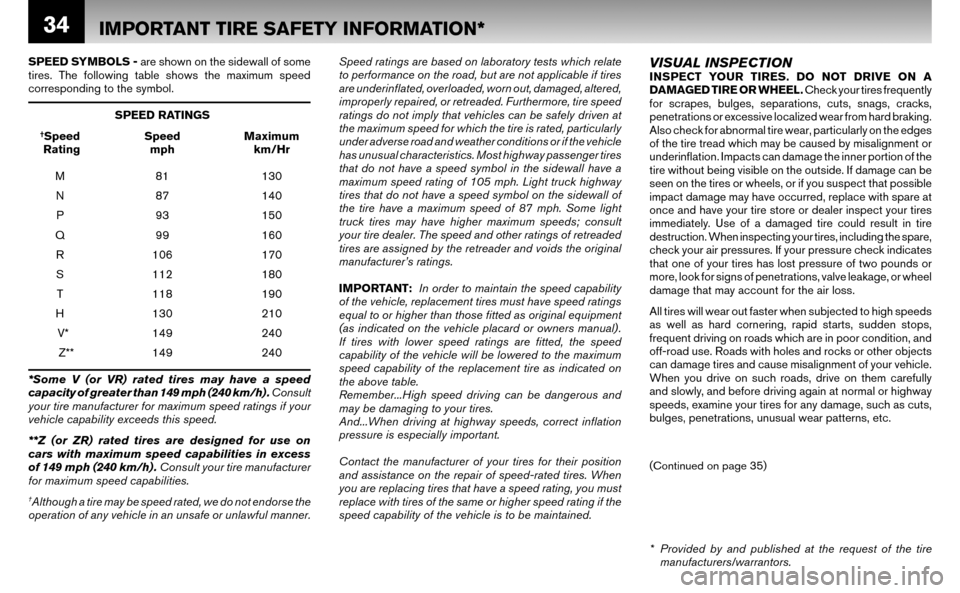
34
SPEED SYMBOLS - are shown on the sidewall of some
tires. The following table shows the maximum speed
corresponding to the symbol.
SPEED RATINGS
†Speed Speed Maximum
Rating mph km/Hr
M 81 130
N 87 140
P 93 150
Q 99 160
R 106 170
S 112 180
T 118 190
H 130 210
V* 149 240
Z** 149 240
*Some V (or VR) rated tires may have a speed
capacity of greater than 149 mph (240 km/h) . Consult
your tire manufacturer for maximum speed ratings if your
vehicle capability exceeds this speed.
**Z (or ZR) rated tires are designed for use on
cars with maximum speed capabilities in excess
of 149 mph (240 km/h) . Consult your tire manufacturer
for maximum speed capabilities.
†Although a tire may be speed rated, we do not endorse the
operation of any vehicle in an unsafe or unlawful manner. Speed ratings are based on laboratory tests which relate
to performance on the road, but are not applicable if tires
are underinfl
ated, overloaded, worn out, damaged, altered,
improperly repaired, or retreaded. Furthermore, tire speed
ratings do not imply that vehicles can be safely driven at
the maximum speed for which the tire is rated, particularly
under adverse road and weather conditions or if the vehicle
has unusual characteristics. Most highway passenger tires
that do not have a speed symbol in the sidewall have a
maximum speed rating of 105 mph. Light truck highway
tires that do not have a speed symbol on the sidewall of
the tire have a maximum speed of 87 mph. Some light
truck tires may have higher maximum speeds; consult
your tire dealer. The speed and other ratings of retreaded
tires are assigned by the retreader and voids the original
manufacturer’s ratings.
IMPORTANT: In order to maintain the speed capability
of the vehicle, replacement tires must have speed ratings
equal to or higher than those fi tted as original equipment
(as indicated on the vehicle placard or owners manual) .
If tires with lower speed ratings are fi tted, the speed
capability of the vehicle will be lowered to the maximum
speed capability of the replacement tire as indicated on
the above table.
Remember...High speed driving can be dangerous and
may be damaging to your tires.
And...When driving at highway speeds, correct infl ation
pressure is especially important.
Contact the manufacturer of your tires for their position
and assistance on the repair of speed-rated tires. When
you are replacing tires that have a speed rating, you must
replace with tires of the same or higher speed rating if the
speed capability of the vehicle is to be maintained.
VISUAL INSPECTIONINSPECT YOUR TIRES. DO NOT DRIVE ON A
DAMAGED TIRE OR WHEEL. Check your tires frequently
for scrapes, bulges, separations, cuts, snags, cracks,
penetrations or excessive localized wear from hard braking.
Also check for abnormal tire wear, particularly on the edges
of the tire tread which may be caused by misalignment or
underinfl ation. Impacts can damage the inner portion of the
tire without being visible on the outside. If damage can be
seen on the tires or wheels, or if you suspect that possible
impact damage may have occurred, replace with spare at
once and have your tire store or dealer inspect your tires
immediately. Use of a damaged tire could result in tire
destruction. When inspecting your tires, including the spare,
check your air pressures. If your pressure check indicates
that one of your tires has lost pressure of two pounds or
more, look for signs of penetrations, valve leakage, or wheel
damage that may account for the air loss.
All tires will wear out faster when subjected to high speeds
as well as hard cornering, rapid starts, sudden stops,
frequent driving on roads which are in poor condition, and
off-road use. Roads with holes and rocks or other objects
can damage tires and cause misalignment of your vehicle.
When you drive on such roads, drive on them carefully
and slowly, and before driving again at normal or highway
speeds, examine your tires for any damage, such as cuts,
bulges, penetrations, unusual wear patterns, etc.
* Provided by and published at the request of the tire manufacturers/warrantors.
IMPORTANT TIRE SAFETY INFORMATION*
(Continued on page 35)
Page 39 of 54
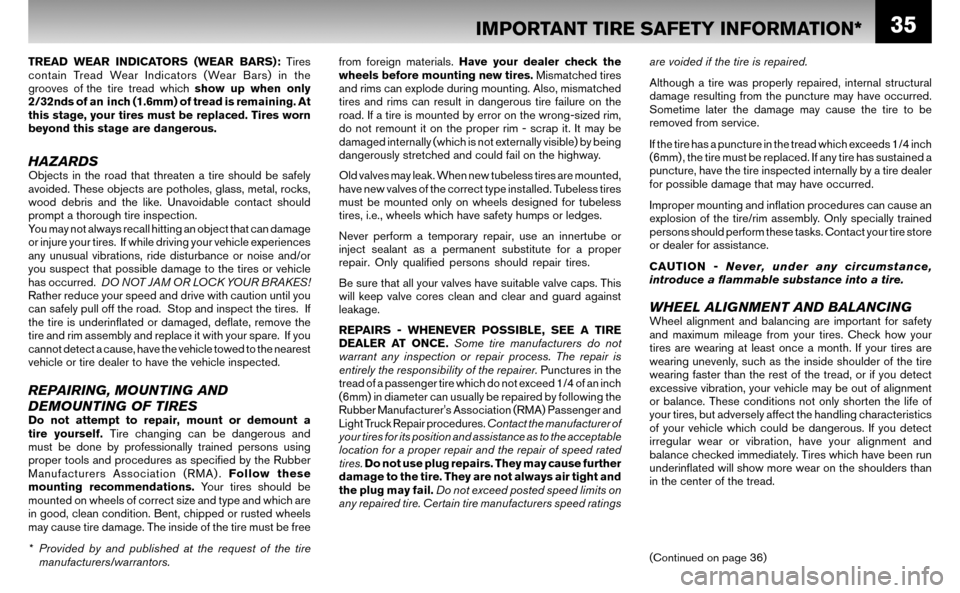
35
TREAD WEAR INDICATORS (WEAR BARS): Tires
contain Tread Wear Indicators (Wear Bars) in the
grooves of the tire tread which show up when only
2/32nds of an inch (1.6mm) of tread is remaining. At
this stage, your tires must be replaced. Tires worn
beyond this stage are dangerous.
HAZARDSObjects in the road that threaten a tire should be safely
avoided. These objects are potholes, glass, metal, rocks,
wood debris and the like. Unavoidable contact should
prompt a thorough tire inspection.
You may not always recall hitting an object that can damage
or injure your tires. If while driving your vehicle experiences
any unusual vibrations, ride disturbance or noise and/or
you suspect that possible damage to the tires or vehicle
has occurred. DO NOT JAM OR LOCK YOUR BRAKES!
Rather reduce your speed and drive with caution until you
can safely pull off the road. Stop and inspect the tires. If
the tire is underinfl ated or damaged, defl ate, remove the
tire and rim assembly and replace it with your spare. If you
cannot detect a cause, have the vehicle towed to the nearest
vehicle or tire dealer to have the vehicle inspected.
REPAIRING, MOUNTING AND
DEMOUNTING OF TIRES
Do not attempt to repair, mount or demount a
tire yourself. Tire changing can be dangerous and
must be done by professionally trained persons using
proper tools and procedures as specifi ed by the Rubber
Manufacturers Association (RMA) . Follow these
mounting recommendations. Your tires should be
mounted on wheels of correct size and type and which are
in good, clean condition. Bent, chipped or rusted wheels
may cause tire damage. The inside of the tire must be free from foreign materials. Have your dealer check the
wheels before mounting new tires.
Mismatched tires
and rims can explode during mounting. Also, mismatched
tires and rims can result in dangerous tire failure on the
road. If a tire is mounted by error on the wrong-sized rim,
do not remount it on the proper rim - scrap it. It may be
damaged internally (which is not externally visible) by being
dangerously stretched and could fail on the highway.
Old valves may leak. When new tubeless tires are mounted,
have new valves of the correct type installed. Tubeless tires
must be mounted only on wheels designed for tubeless
tires, i.e., wheels which have safety humps or ledges.
Never perform a temporary repair, use an innertube or
inject sealant as a permanent substitute for a proper
repair. Only qualifi ed persons should repair tires.
Be sure that all your valves have suitable valve caps. This
will keep valve cores clean and clear and guard against
leakage.
REPAIRS - WHENEVER POSSIBLE, SEE A TIRE
DEALER AT ONCE. Some tire manufacturers do not
warrant any inspection or repair process. The repair is
entirely the responsibility of the repairer. Punctures in the
tread of a passenger tire which do not exceed 1/4 of an inch
(6mm) in diameter can usually be repaired by following the
Rubber Manufacturer's Association (RMA) Passenger and
Light Truck Repair procedures. Contact the manufacturer of
your tires for its position and assistance as to the acceptable
location for a proper repair and the repair of speed rated
tires. Do not use plug repairs. They may cause further
damage to the tire. They are not always air tight and
the plug may fail. Do not exceed posted speed limits on
any repaired tire. Certain tire manufacturers speed ratings are voided if the tire is repaired.
Although a tire was properly repaired, internal structural
damage resulting from the puncture may have occurred.
Sometime later the damage may cause the tire to be
removed from service.
If the tire has a puncture in the tread which exceeds 1/4 inch
(6mm) , the tire must be replaced. If any tire has sustained a
puncture, have the tire inspected internally by a tire dealer
for possible damage that may have occurred.
Improper mounting and infl ation procedures can cause an
explosion of the tire/rim assembly. Only specially trained
persons should perform these tasks. Contact your tire store
or dealer for assistance.
CAUTION - Never, under any circumstance,
introduce a fl ammable substance into a tire.
WHEEL ALIGNMENT AND BALANCINGWheel alignment and balancing are important for safety
and maximum mileage from your tires. Check how your
tires are wearing at least once a month. If your tires are
wearing unevenly, such as the inside shoulder of the tire
wearing faster than the rest of the tread, or if you detect
excessive vibration, your vehicle may be out of alignment
or balance. These conditions not only shorten the life of
your tires, but adversely affect the handling characteristics
of your vehicle which could be dangerous. If you detect
irregular wear or vibration, have your alignment and
balance checked immediately. Tires which have been run
underinfl ated will show more wear on the shoulders than
in the center of the tread.
* Provided by and published at the request of the tire manufacturers/warrantors.
IMPORTANT TIRE SAFETY INFORMATION*
(Continued on page 36)